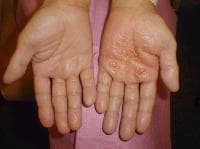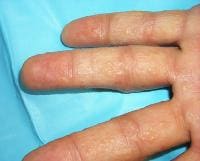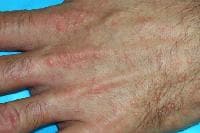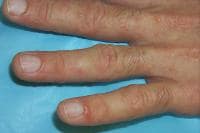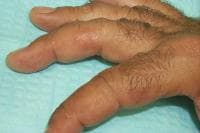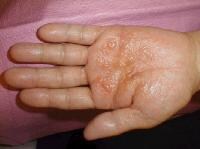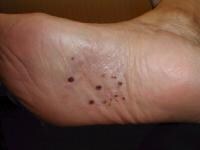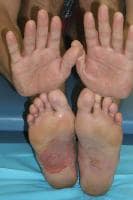Hormonal disorders are conditions that affect the endocrine system and the hormones they release. As such the effect of hormonal disorders can range throughout the whole body as different disorders can manifest in different areas. Hormone levels typically decrease with age and while some do not, hormone receptors become less active and cause certain changes to the body. However, simply replacing deficient hormones do not simply cure the problems caused and may even be harmful. Thus, treating hormonal disorders is not a simple task. Hormones are produced primarily in the endocrine glands but certain parts of the body such as the kidney or the placenta can also release hormones in conjunction with the endocrine system. Some glands in the body also produce not hormones but other substances such as the salivary gland and the sweat glands.
Typically hormone disorders involve either an overproduction by hyperactive glands or deficiency of a certain hormone by hypoactive glands. This may be due to a problem in the endocrine gland responsible for the production of the said hormone or the hypothalamus and the pituitary gland (sometimes referred to as the master gland) sending wrong signals to the body.
Impairment of normal bodily functions results from hormonal disorder. For example, those suffering from diabetes suffer from a low production or poor reception of insulin, a hormone responsible for metabolizing sugars. Thus they experience elevated blood sugar levels. Overproduction of the growth hormone from the pituitary glands causes a massive and sometimes uncontrollable growth spurt, causing individuals to be abnormally tall. This condition is known as gigantism. Thyroid disorders can produce a variety of different conditions from metabolic problems to blood pressure issues. Some hormones such as prolactin can even stimulate the growth of tumors, such as breast cancer. Thus depending on the hormonal disorder, the manifested symptoms may vary greatly. Some may not even manifest symptoms immediately until the problem is severe. A blood test may help the doctor check hormone levels in the blood, or the doctor may ask you to perform certain actions or take certain food or medicine to stimulate hormone production and observe its effects. Examples of this treatment include consumption of sugary foods to induce insulin production, or asking the patient to fast.
There are many different causes of hormonal disorders. Some may be genetically linked, as some may seem to run within the family, such as diabetes. Others may involve nutritional factors. Goiter, the condition of enlargement of the thyroid gland, is related to a lack of iodine in the diet, while diabetes, a lack of the hormone insulin or the body’s poor reception to it, can be aggravated by a sugar and carbohydrate-rich diet. Age also plays a factor in the development of hormonal disorders, especially in the production of sex hormones which reduces in both sexes as they age. This is the reason why women experience menopause. Injury to the hormone producing organs can also cause inhibition or overstimulation of hormone production.
Sometimes autoimmune disorders can affect the hormone production by attacking hormone production sites in the body, disrupting the normal processes of the organ. Tumors can also grow on hormone producing organs and cause an overproduction of the hormone or stifle hormone producing tissue in their growth, causing a decrease in hormone production. Other factors that may affect hormone production include stress, infection and changes in your blood chemistry and electrolyte balance.
Problems in the pituitary gland in particular can cause a wide range of other hormonal disorders, since it controls most of the other glands in the body such as thyroid-stimulating hormone deficiency.
Recent studies also show that certain chemicals described as “endocrine disruptors” play a part in causing hormonal disorders. These endocrine disruptors may mimic the effects or slightly mimic the effects of naturally-occurring hormones, causing an overstimulation of processes. Some may bind to the hormone receptors located in different parts of the body. When the body normally produces hormones, the receptors fail to pick up the signal and thus the body cannot respond properly. Others may disrupt the production of the hormones themselves, or the action of the receptors. These endocrine disruptors may find its way in daily household objects, cosmetics and even our food. Some evidence has shown that these endocrine disruptors may also change the expression of DNA and their effects may be passed on to the next generation.
Hormone replacement therapy is a popular treatment to many types of hormonal disorders. Hormonal supplements may come in oral or intravenous form. However, not all hormonal disorders may be treated with hormone replacement therapy. An example is in women who experience menopause, where hormone replacement therapy may increase risks in certain cancers and cardiovascular diseases. Others such depend on maintenance drugs that mimic the hormone’s action or increase the body’s reception to the hormone. Supplements may also help restore normal hormone development as some may be caused by deficiencies in certain vitamins or minerals. In extreme cases of hormone over production, surgical means may be used to treat the over production. Corrective surgery to the involved hormone producing sites may be used to stem the production of hormones, such as in the pituitary gland in cases of gigantism. Certain drugs can also block the production of overproduced hormones or bind to their receptors to reduce their effect.
If hormonal disorders prevent proper balance of body chemistry or the metabolizing of certain nutrients, then an adjustment in diet may be helpful in lessening the pressure on the body. This is particularly useful in diabetes and thyroid conditions. Exercise may also help release some hormones as well as help facilitate metabolic processes. Proper treatment of individual disorders should be facilitated by the doctor based on the patient’s condition, medical history, and other personal details.
Typically hormone disorders involve either an overproduction by hyperactive glands or deficiency of a certain hormone by hypoactive glands. This may be due to a problem in the endocrine gland responsible for the production of the said hormone or the hypothalamus and the pituitary gland (sometimes referred to as the master gland) sending wrong signals to the body.
Impairment of normal bodily functions results from hormonal disorder. For example, those suffering from diabetes suffer from a low production or poor reception of insulin, a hormone responsible for metabolizing sugars. Thus they experience elevated blood sugar levels. Overproduction of the growth hormone from the pituitary glands causes a massive and sometimes uncontrollable growth spurt, causing individuals to be abnormally tall. This condition is known as gigantism. Thyroid disorders can produce a variety of different conditions from metabolic problems to blood pressure issues. Some hormones such as prolactin can even stimulate the growth of tumors, such as breast cancer. Thus depending on the hormonal disorder, the manifested symptoms may vary greatly. Some may not even manifest symptoms immediately until the problem is severe. A blood test may help the doctor check hormone levels in the blood, or the doctor may ask you to perform certain actions or take certain food or medicine to stimulate hormone production and observe its effects. Examples of this treatment include consumption of sugary foods to induce insulin production, or asking the patient to fast.
There are many different causes of hormonal disorders. Some may be genetically linked, as some may seem to run within the family, such as diabetes. Others may involve nutritional factors. Goiter, the condition of enlargement of the thyroid gland, is related to a lack of iodine in the diet, while diabetes, a lack of the hormone insulin or the body’s poor reception to it, can be aggravated by a sugar and carbohydrate-rich diet. Age also plays a factor in the development of hormonal disorders, especially in the production of sex hormones which reduces in both sexes as they age. This is the reason why women experience menopause. Injury to the hormone producing organs can also cause inhibition or overstimulation of hormone production.
Sometimes autoimmune disorders can affect the hormone production by attacking hormone production sites in the body, disrupting the normal processes of the organ. Tumors can also grow on hormone producing organs and cause an overproduction of the hormone or stifle hormone producing tissue in their growth, causing a decrease in hormone production. Other factors that may affect hormone production include stress, infection and changes in your blood chemistry and electrolyte balance.
Problems in the pituitary gland in particular can cause a wide range of other hormonal disorders, since it controls most of the other glands in the body such as thyroid-stimulating hormone deficiency.
Recent studies also show that certain chemicals described as “endocrine disruptors” play a part in causing hormonal disorders. These endocrine disruptors may mimic the effects or slightly mimic the effects of naturally-occurring hormones, causing an overstimulation of processes. Some may bind to the hormone receptors located in different parts of the body. When the body normally produces hormones, the receptors fail to pick up the signal and thus the body cannot respond properly. Others may disrupt the production of the hormones themselves, or the action of the receptors. These endocrine disruptors may find its way in daily household objects, cosmetics and even our food. Some evidence has shown that these endocrine disruptors may also change the expression of DNA and their effects may be passed on to the next generation.
Hormone replacement therapy is a popular treatment to many types of hormonal disorders. Hormonal supplements may come in oral or intravenous form. However, not all hormonal disorders may be treated with hormone replacement therapy. An example is in women who experience menopause, where hormone replacement therapy may increase risks in certain cancers and cardiovascular diseases. Others such depend on maintenance drugs that mimic the hormone’s action or increase the body’s reception to the hormone. Supplements may also help restore normal hormone development as some may be caused by deficiencies in certain vitamins or minerals. In extreme cases of hormone over production, surgical means may be used to treat the over production. Corrective surgery to the involved hormone producing sites may be used to stem the production of hormones, such as in the pituitary gland in cases of gigantism. Certain drugs can also block the production of overproduced hormones or bind to their receptors to reduce their effect.
If hormonal disorders prevent proper balance of body chemistry or the metabolizing of certain nutrients, then an adjustment in diet may be helpful in lessening the pressure on the body. This is particularly useful in diabetes and thyroid conditions. Exercise may also help release some hormones as well as help facilitate metabolic processes. Proper treatment of individual disorders should be facilitated by the doctor based on the patient’s condition, medical history, and other personal details.

